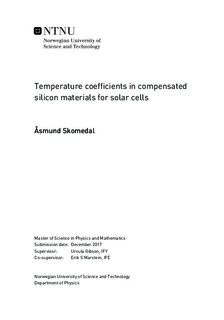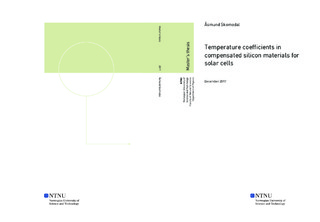| dc.description.abstract | The pricing of solar modules is closely connected to the rating at standard testing conditions (STC). Lately more emphasis has been put on the relationship between field performance of PV-modules and the temperature sensitivity of cells. As it turns out, a benefit in
the performance of cells made of Elkem Solar Silicon
R (ESS) in high temperature, high irradiance areas relative to polysilicon cells has been showed. This benefit has been ascribed
better temperature coefficients (TCs) in the cell parameters. In this thesis the physical
phenomena behind the TCs are investigated. Through temperature and injection dependent lifetime spectroscopy (TIDLS) measurements of wafers, and temperature dependent
IV-measurements of Passivated Emitter and Rear Contact (PERC-) cells, made of both
ESS and polysilicon, an experimental foundation for the understanding these phenomena
is built.
More importantly, the experimental results are used in the development of an advanced
cell-model in an updated version of the device modeling software PC1Dmod 6.2. The
model is verified by comparison to the measurements. Further, the independent and joint
effect of varying the material parameters (such as compensation level, effective doping
level and bulk lifetime) on the performance and temperature sensitivity of solar cells of
different quality is investigated. In the end, a comprehensive understanding of the phenomena involved is reached, and novel knowledge relevant for compensation engineering
is acquired.
The conclusion is that the most decisive material parameters for the temperature sensitivity of the measured PERC-cells is the the bulk lifetime and its temperature coefficient,
and that any benefit in the TCs of ESS-cells relative to similarly rated polysilicon-cells
probably stems from higher bulk lifetimes. However, this should not lead to the conclusion that ESS-cells in general have higher lifetimes; instead this comes down to the fact
that if an ESS-cell and a polysilicon-cell are to have similar efficiencies, the ESS-cell necessarily needs to have higher lifetimes, and thus it will have better TCs too. Still, this
should be considered in the pricing of the cells, since it might lead to relatively high performance ratios in ESS-cells, compared to polysilicon cells, especially in hot locations
with high levels of irradiation | |

